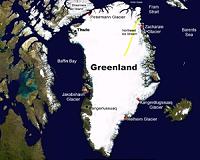| . |  |
. |
Washington DC (SPX) Mar 26, 2010 Ice loss from the Greenland ice sheet, which has been increasing during the past decade over its southern region, is now moving up its northwest coast, according to a new international study. The research indicates the ice-loss acceleration began moving up the northwest coast of Greenland staring in late 2005. The team drew their conclusions by comparing data from NASA's Gravity and Recovery Climate Experiment satellite system, or GRACE, with continuous GPS measurements made from long-term sites on bedrock on the edges of the ice sheet. The data from the GPS and GRACE provided the researchers with monthly averages of crustal uplift caused by ice-mass loss. The team, which includes researchers from Denmark's Technical Institute's National Space Institute in Copenhagen and University of Colorado at Boulder, combined the uplift measured by GRACE over United Kingdom-sized chunks of Greenland, while the GPS receivers monitored crustal uplift on scales of just tens of miles. "Our results show that the ice loss, which has been well documented over southern portions of Greenland, is now spreading up along the northwest coast," says Shfaqat Abbas Khan, lead author on a paper that was published March 19, in Geophysical Research Letters, a publication of the American Geophysical Union (AGU). The team found that uplift rates near the Thule Air Base on Greenland's northwest coast rose by about 4 centimeters, or roughly 1.5 inches, from October 2005 to August 2009. Although the low resolution of GRACE - a swath of about 250 kilometers, or 155 miles, across - is not precise enough to pinpoint the source of the ice loss, the fact that the ice sheet is losing mass nearer to the ice sheet margins suggests the flows of Greenland outlet glaciers there are increasing in velocity, said the study authors. "When we look at the monthly values from GRACE, the ice mass loss has been very dramatic along the northwest coast of Greenland," says CU-Boulder physics professor and study co-author John Wahr, also a fellow at CU-Boulder's Cooperative Institute for Research in Environmental Sciences. "This is a phenomenon that was undocumented before this study," Wahr says. "Our speculation is that some of the big glaciers in this region are sliding downhill faster and dumping more ice in the ocean."
Other co-authors on the new study are Michael Bevis and Eric Kendrick from Ohio State University, Columbus, and Isabella Velicogna of the University of California-Irvine, who also is a scientist at NASA's Jet Propulsion Laboratory in Pasadena, Calif. A 2009 study by Velicogna, published also in Geophysical Research Letters, showed that between April 2002 and February 2009, the Greenland ice sheet shed roughly 1,605 cubic kilometers (385 cubic miles) of ice. The mass loss is equivalent to about 0.5 millimeters (0.02 inches) of global sea-level rise per year. "These changes on the Greenland ice sheet are happening fast, and we are definitely losing more ice mass than we had anticipated," says Velicogna. "We also are seeing this trend in Antarctica, a sign that warming temperatures really are having an effect on ice in Earth's cold regions." Researchers have been gathering data from GRACE since NASA launched the system in 2002. Two GRACE satellites whip around Earth 16 times a day separated by 220 kilometers (137 miles) and measure changes in Earth's gravity field caused by regional shifts in the planet's mass, including ice sheets, oceans and water stored in the soil and in underground aquifers "GRACE is unique in that it allows us see changes in the ice mass in almost real time," says Velicogna. "Combining GRACE data with the separate signals from GPS stations gives us a very powerful tool that improves our resolution and allows us to better understand the changes that are occurring." In addition to monitoring the Thule GPS receiver in northwest Greenland as part of the new study, the team also is taking data from GPS receivers in southern Greenland near the towns of Kellyville and Kulusuk. An additional 51 permanent GPS stations recently set up around the edges of the Greenland ice sheet should be useful to measure future up crustal uplift and corresponding ice loss, says Wahr. "If this activity in northwest Greenland continues and really accelerates some of the major glaciers in the area - like the Humboldt Glacier and the Peterman Glacier - Greenland's total ice loss could easily be increased by additional 50 to 100 cubic kilometers, (12 to 24 cubic miles) within a few years," Khan says. A 2006 study by Wahr and Velicogna using the GRACE satellite indicated that Greenland lost roughly 684 cubic kilometers (164 cubic miles) of ice from April 2004 to April 2006 - more than the volume of water in Lake Erie.
Share This Article With Planet Earth
Related Links Grace at JPL Climate at JPL Beyond the Ice Age
 Icebridge To Study Arctic Glaciers
Icebridge To Study Arctic GlaciersGreenbelt MD (SPX) Mar 19, 2010 NASA's Operation IceBridge mission, the largest airborne survey ever flown of Earth's polar ice, kicks off its second year of study when NASA aircraft arrive in Greenland March 22. The IceBridge mission allows scientists to track changes in the extent and thickness of polar ice, which is important for understanding ice dynamics. IceBridge began in March 2009 as a means to fill the gap in p ... read more |
|
| The content herein, unless otherwise known to be public domain, are Copyright 1995-2010 - SpaceDaily. AFP and UPI Wire Stories are copyright Agence France-Presse and United Press International. ESA Portal Reports are copyright European Space Agency. All NASA sourced material is public domain. Additional copyrights may apply in whole or part to other bona fide parties. Advertising does not imply endorsement,agreement or approval of any opinions, statements or information provided by SpaceDaily on any Web page published or hosted by SpaceDaily. Privacy Statement |